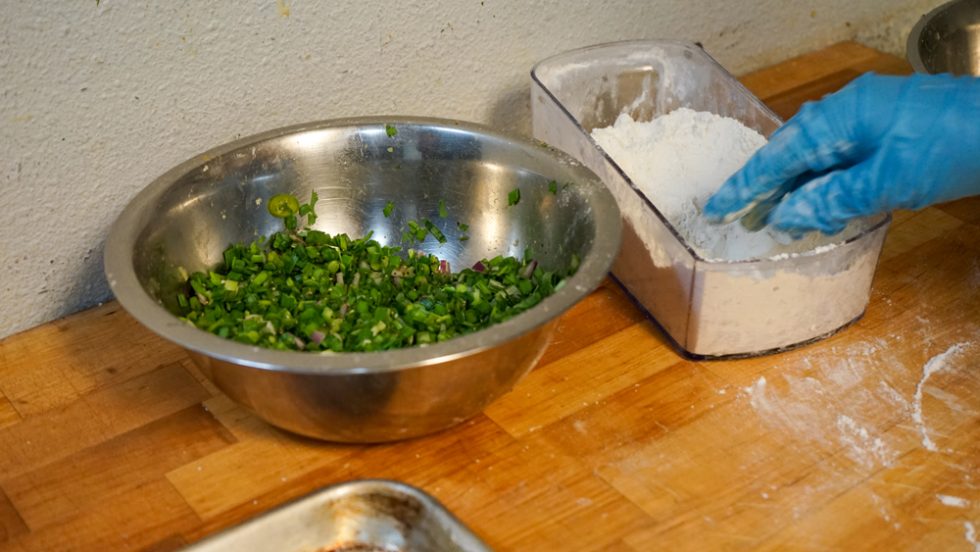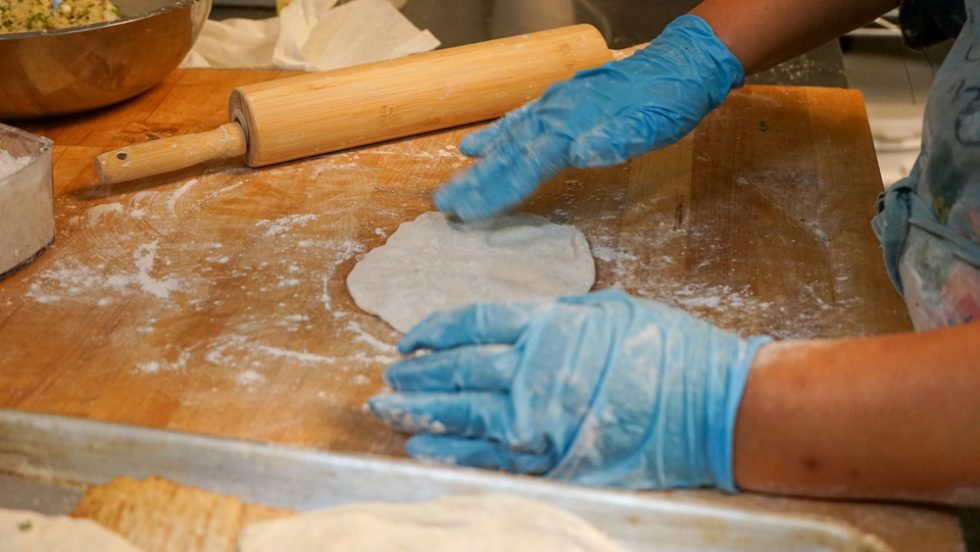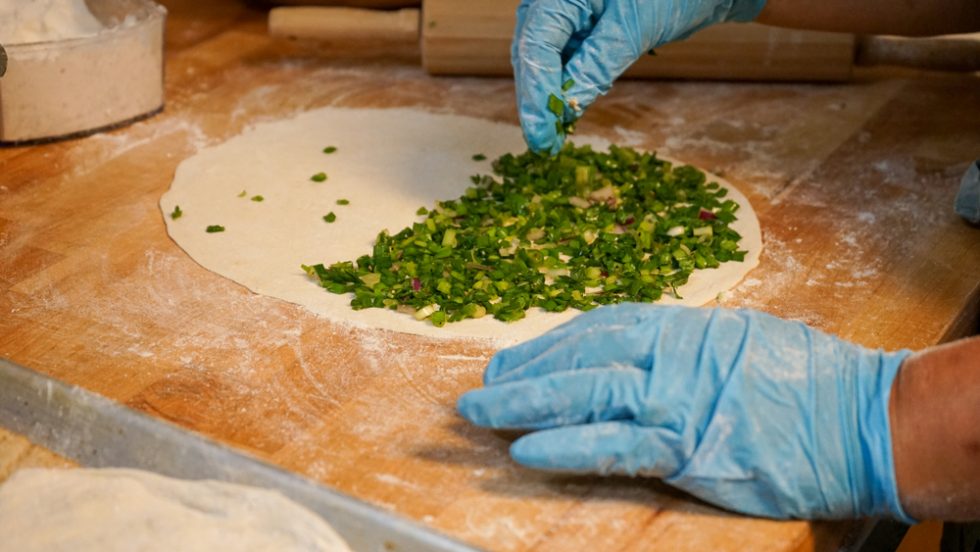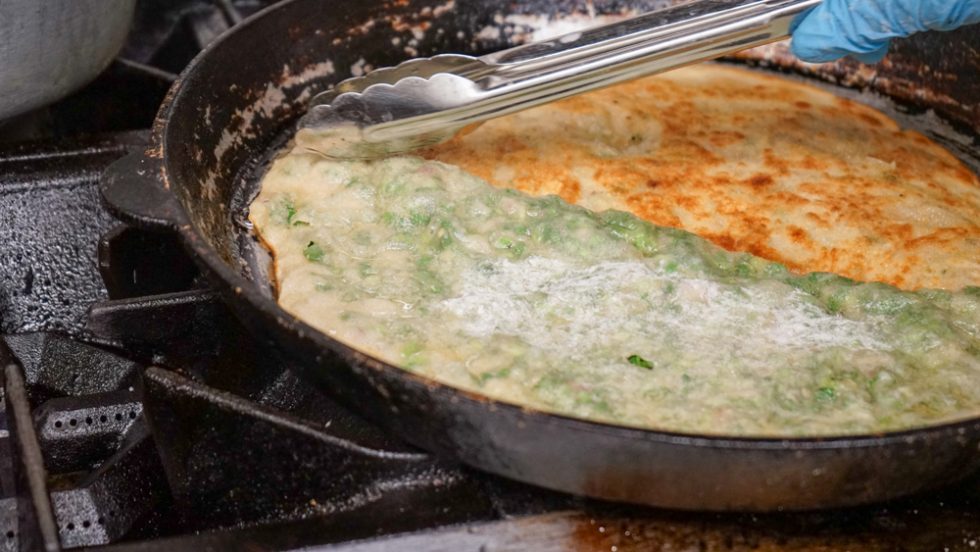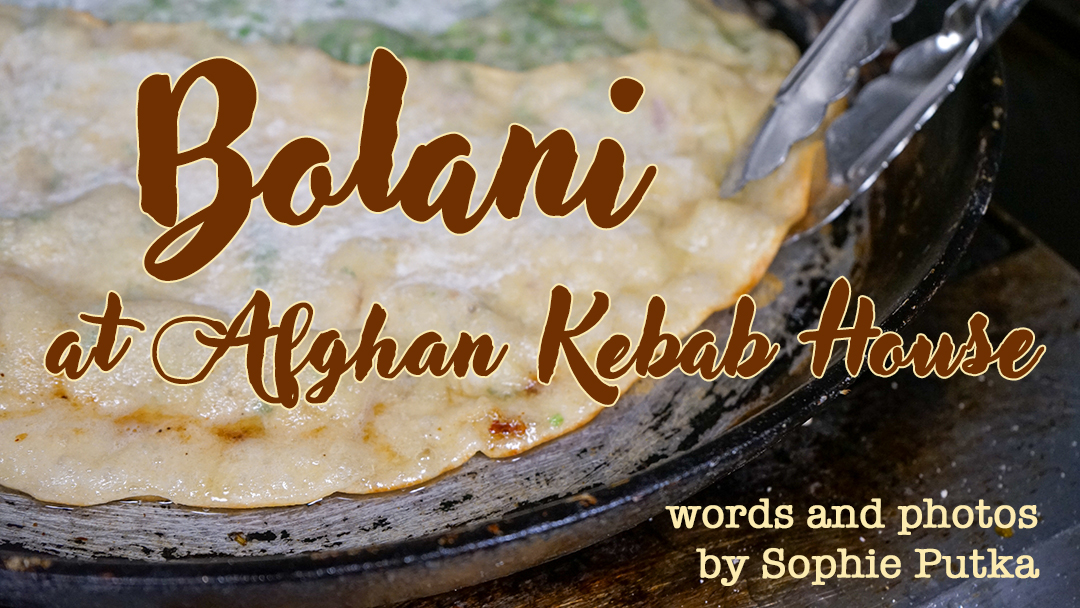
If you’re a curious eater of many cuisines, you may have noticed certain patterns that, despite thousands of miles between nations, have a delightful way of repeating. It seems every country has their own version of the stew, the meatball, and the dumpling. And from naan and pita to pajeon, injera to arepas, flatbread is another one of those universal foods reminding us that humans are a lot more alike than we are different.
At Afghan Kebab House, a recent addition to Albuquerque’s downtown restaurant lineup, the bolani is a perfect embodiment of flatbread’s diversity. It’s an irresistible combo of simple dough and leek or potato filling, fried to crisp, chewy perfection, and served with a zesty chutney for dipping. Bolani is also a testament to the diversity of Afghan food itself—and of the menu at Afghan Kebab House, which is more extensive than their name might suggest.

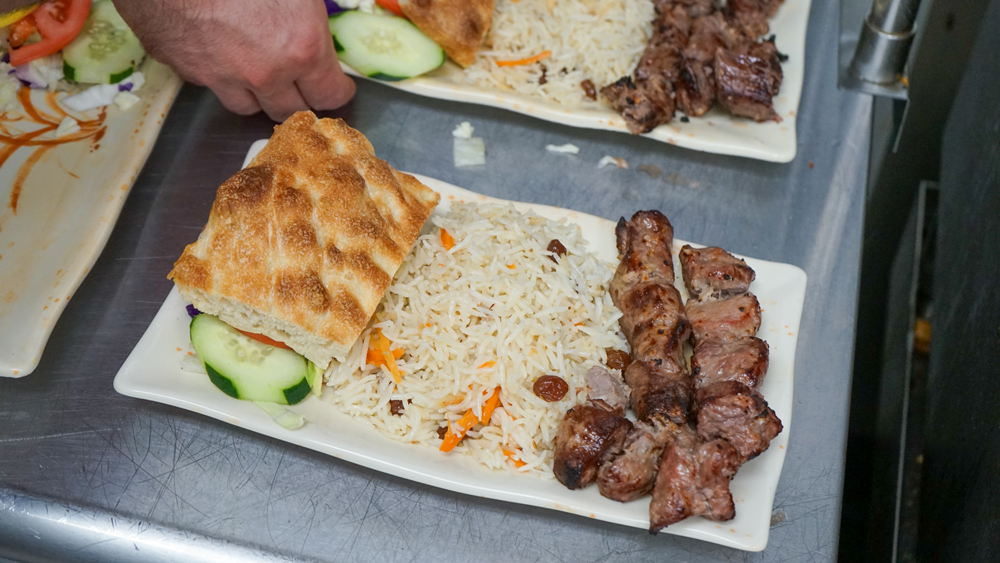
Afghan food, like most other cuisines, has varied influences that round out its own unique flavors: coriander and mint from Persia, saffron and garam masala from India, and a dose of dumplings from Central Asia. But the star of the table is undoubtedly rice: here at Afghan Kebab House, they use rice from Afghanistan that cooks into extraordinarily long, firm curls, dotted with the traditional additions of raisins and carrots.
Unlike rice, bolani isn’t necessarily an everyday food—typically, it’s served at parties and other special occasions, though it’s also sold at street stands and kebab houses across Kabul and Kandahar. Like some flatbreads and other filled doughs (think tamales), this is a snack best assembled in volume to feed many mouths at a time.
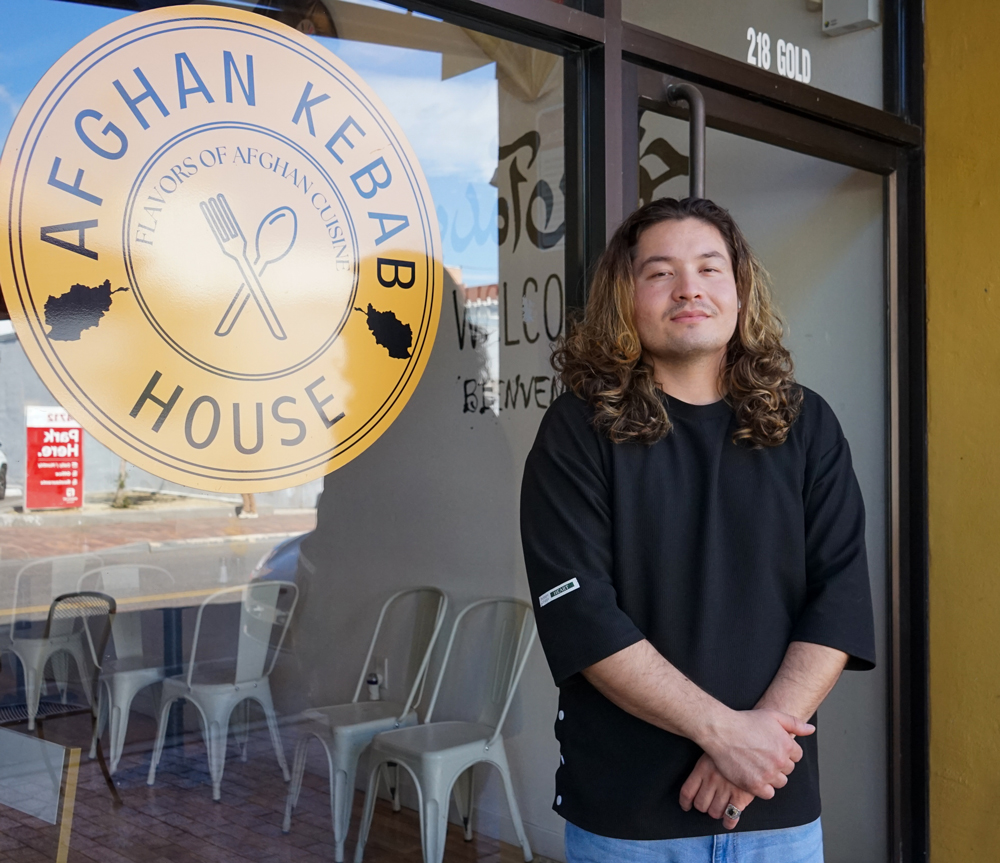
It’s a typically dry, clear desert morning when I park on Second Street and sip a coffee at Espresso Fino, excited to meet Afghan Kebab House’s owner again and to witness this comforting dish come together in the kitchen.
The first time we met, owner Ilhamuddin Hussaini, or Ilham, walked me through the path that led him to open a restaurant. Two years after his brother, who had been an interpreter for the Marine Corps, came to the United States, Ilham followed with the rest of his family in 2016. Growing up, his parents had a jewelry business, selling their creations to a mostly American military clientele. And much about Albuquerque, especially the dry, mountainous climate, seemed like home. He said he asked his brother when they first flew here, “Did the flight just land back in Kabul?”
“I’m very comfortable here, like Albuquerque gave me everything,” Ilham said. “If I was in Afghanistan, I don’t even know if I would have been alive right now.”
After working various jobs, including a stint at the University of New Mexico’s psychiatric center, and finishing up an associate’s degree in business last year, Ilham saw an opportunity to own a small business, which he’d wanted for some time.
“Not a lot of people really know about the culture and the food and everything, even though there’s so much history between America and Afghanistan,” he said. “And again, there was really no Afghan restaurant, and I just wanted to bring it out here, show our food, our culture, a little bit.” When he found the downtown location, Ilham quit his job at the University of New Mexico, and shortly after, the restaurant was up and running. It opened in April, and Ilham and his family have been sharing Afghan food with Burqueños—for many, their first taste—ever since.
Stationed at a large table with bowls of carefully prepared chopped leeks and a soft mash of potato pieces is the woman who arguably represents the heart of Ilham’s restaurant: his mother, Zohra Hussaini. As I watch, she rolls out balls of dough that have been resting underneath a colorful cloth. The dough for bolani is made by hand from four simple ingredients: flour, water, salt, and yeast. Using just a few motions, Zohra flattens the dough into a thin, nearly perfect circle, and spreads the leek filling across half. One fold later, she transfers the half-circle onto a pan and presses the pocket closed along its edge with quick movements, sealing it and showering it with a dusting of flour.
The leeks pressed into the dough aren’t the garden-variety club-shaped giants you’d find at the grocery store. Zohra is using Chinese chives (also known as garlic chives), a mild allium close to the Afghan leek known as gandana in Dari, one of two official languages spoken in Afghanistan (the other is Pashto). This bunch came from Talin market, Zohra said. Mixed with red onion and a few other spices and herbs, they are the secret to the leek bolani. The second filling they offer is cooked potato and cilantro, with additional spices. A typical spice profile in Afghan cooking includes cumin, coriander, turmeric, and cardamom, though the family keeps the exact details of their spice blends to themselves.
Zohra learned to cook from her mother from a young age, as did the rest of the girls in her family, she tells me. Of her nine children, many are accomplished cooks, including one son, she says, smiling, who is “better than me!” He makes a mean bun kebab, which is like a burger (sometimes made with potato and lentil instead of meat) in a bun with chutney.
When it’s time to fry the bolani, Zohra gently places the leek-filled pockets into a giant hot pan with a thin layer of vegetable oil, pressing them down to create even browning. After a few minutes of sizzling, and a few more squeezes of oil around their perimeter from a bottle, Zohra checks the underside for the perfect shade of golden brown. She flips one half circle, then the other. When both sides are crisp, and the dough translucent enough to reveal the flatbread’s contents, the bolani is placed on a platter, ready to serve.

Zohra plates one freshly cooked leek bolani, and Ilham places it in front of me with a little dish of chutney for dipping. “This is a finger food,” he says, and invites me to dive in, tearing pieces off of the huge semicircle to dip in the tangy sauce. Most Afghan foods, I learn, are finger foods, meant to be scooped up with thick Afghan naan. But Ilham had to make some allowances for American sensibilities. “We are in the downtown area, so like most of the businesses . . . people come into their meeting and they don’t want to eat with their hands and everything, which is understandable,” Ilham said. “So . . . we adjusted a little bit.” He serves karahi, a chicken dish with a tomato-based sauce, with rice now.
The bolani is perfectly cooked: not so crispy that it’s brittle, still soft enough to bend a little. The chopped leeks and red onions, gently steamed inside, are pressed into the dough so that none of the filling falls out, even when you tear it into pieces. The chutney, made with tomato, vinegar, and spices, is light but cuts through the richness of the bread with a refreshing tang. As an added bonus, Ilham delivers a huge mug of steaming, buttery-orange saffron tea. Just saffron, water, and a little cardamom, the tea is warming and deeply flavored. It’s also full of health benefits, he adds (saffron is rich in antioxidants and anti-inflammatory compounds, among other properties).
I devour half of the huge leek bolani and order a potato bolani to go, plus a couple (okay, more than a couple) of what may be the best, most fresh-tasting baklava I have ever had—delicate flaky phyllo dough wrapped around a nest of crumbly pistachios. With so many welcome surprises to explore at Afghan Kebab House, that’s a recipe for another day.
📍218 Gold SW, Albuquerque, 505-610-5842
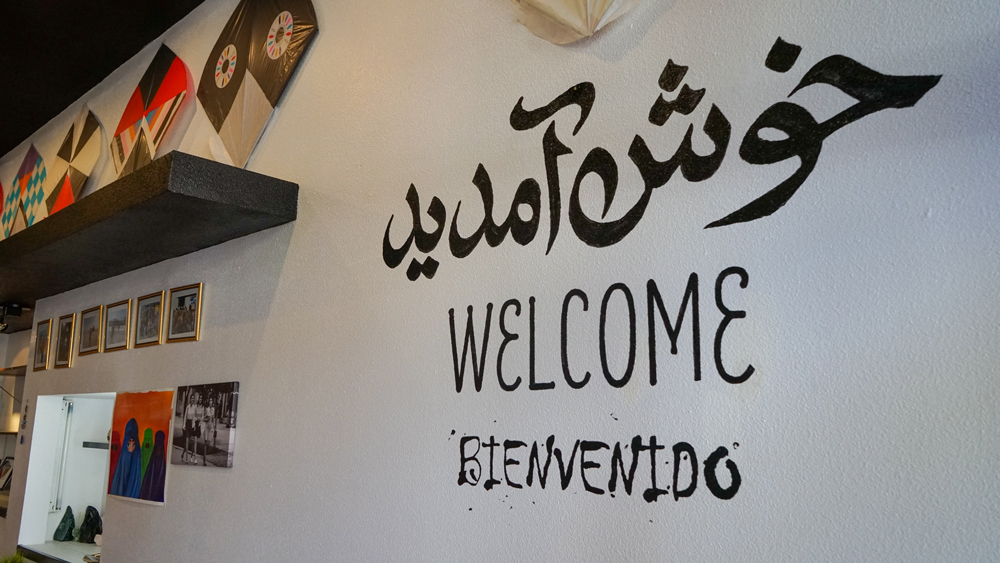
Sophie Putka
Sophie Putka is a full-time journalist and part-time food writer and photographer. She has been a barista, outdoor educator, and mushroom farmer at local New Mexico businesses, and lives in Albuquerque with her dog Iggy.



